#and then i was also reminded that i like revolutionary girl utena's posing
Text
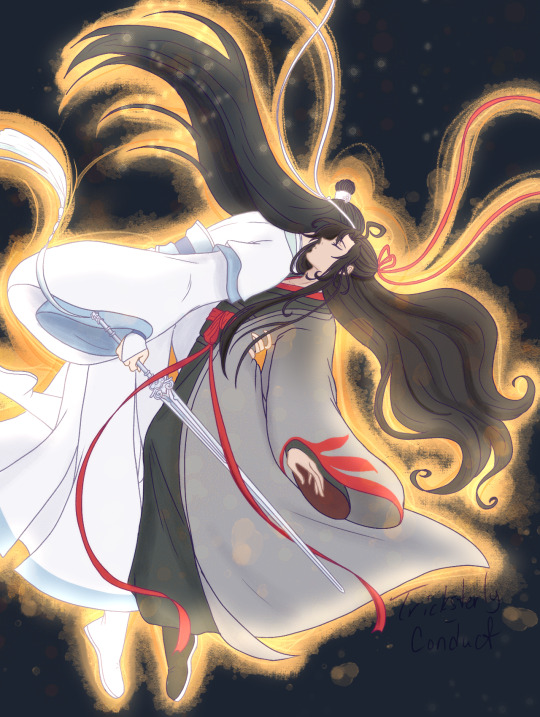
"He is half of my soul, as the poets say. I could recognize him by touch alone, by smell; I would know him blind, by the way his breaths came and his feet struck the earth. I would know him in death, at the end of the world." - Song of Achilles, Madeline Miller
#mdzs#wangxian#lan wangji#wei wuxian#my fanart#the grandmaster of demonic cultivation#grandmaster of demonic arts#mo dao zu shi#yilling patriarch#yilling laozu#hanguang jun#mxtx#song of achilles#i was reminded that song of achilles exists#and then i was also reminded that i like revolutionary girl utena's posing#and then i thought really hard about wangxian#i just love them#i have a lot of feelings about them#why are they glowing gold?#who knows#it's pretty though#honestly the floating and glowing would have probably fit tgcf more#but the song of achilles fits with mdzs so that's what i'm vibing with
398 notes
·
View notes
Photo
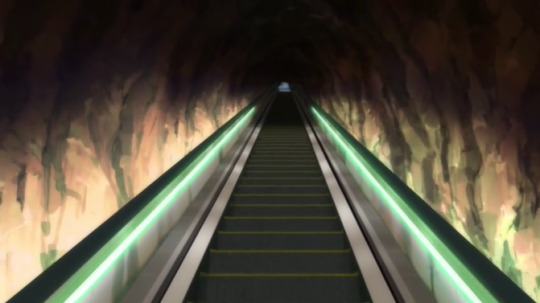


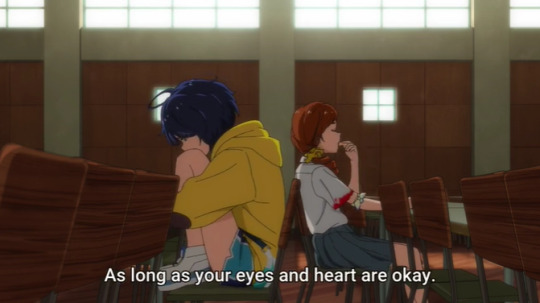
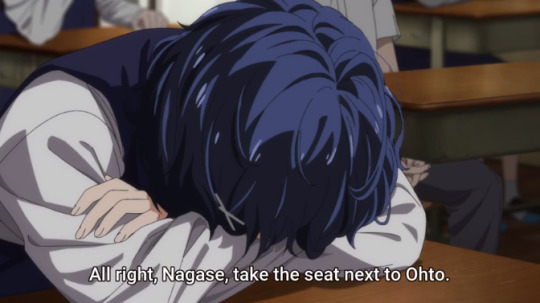

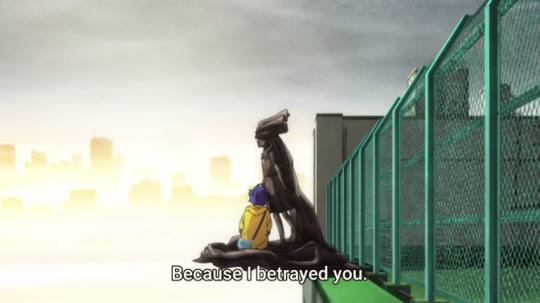



Random Screencaps of Wonder Egg Priority Episode 1 with thoughts for each of those scenes.
When I first saw this scene, I couldn’t help but remember the escalator scene from Us 2019 which also delved into psychological trauma.
Ai’s openly discussing on the various things she could do with her egg reminded me of the Student Council speech from Revolutionary Girl Utena. The theme of the speech being about how kids/teens like them are trapped in their eggs and if they don’t break their shell or overcome their problems, then they risk dying within the egg and being unable to accomplish anything with their lives. In Ai’s case, the series is focusing more on her past traumas and how they’re inhibiting her ability to enjoy life at it’s fullest. She even questions if she should even break the egg to begin with. But as it stands, if she cannot break free from her trauma and grow past them, she could emotionally “die” as a result.
The way Kurumi knows so much about how the Seeno Evils and how they won’t bother Ai makes me wonder how many times she’s been through this survival mission. How many times was she hatched from an egg and partnered up with a designated Dream Warrior? You figure that with how each egg has it’s own code mixed with their being thousands of potential girls in Japan alone who suffer from different types of trauma, that Kurumi would have only one egg and this experience would be new to her. But considering how gacha machines can dispense the same toy or prize, would that mean that Kurumi’s egg was duplicated? Meaning that she can never truly find peace even after her Wonder Killer is defeated since she’ll be hatched once more by a new Dream Warrior?
I’m also concerned about Kurumi stating that Ai will be okay as long as her eyes and heart are okay. Why are those body parts considered the most crucial? I take it there’s symbolism regarding what types of things or truth the eyes can see and how the heart can be your guiding key. So it would be dangerous if either of those were threatened during a mission. But that does bring the question: how many Dream Warriors did Kurumi know who were killed after having their eyes and hearts wounded? And do they simply die as a consequence or is there a fate worse than death?
I’m also curious as to whether Ai was always depressed and miserable. In later episodes, she’s shown to be upbeat, cheerful and quite playful. A far contrast from her miserable personality at school. Was this because of the opportunity of seeing Koito again gave her hope and instilled new happiness in her? Maybe during her elementary years, she was always so happy and fun. But everything changed when she entered middle school and she was bullied by her new classmates. Middle school can be hell for everyone.
The way Koito presents herself to Ai after class feels pretty unusual. She maintains a calm presence as she makes blunt but soft-hearted questions to Ai. She prods the blue haired girl about her game in the hopes of getting to know her and form some type of relation with her. She does have goodness in her heart but her manner of asking feels somewhat invasive. Especially when she brings up Ai’s heterochromia. I suppose it may be because we’re seeing this from Ai’s perspective and how she wanted to be left alone. To her, Koito’s presence made her uncomfortable at the time given how closed off she wanted to be.
I wanted that shot so we can have a reference for what Captured Maiden sculptures look like and because this shot looks gorgeous. It’s also interesting with how Koito is posed as if she’s walking somewhere while her eyes are covered. Is this to show how she’s trapped in the Dream World and made to wander blindly like Kurumi? Waiting to be rescued?
The final minutes confirm that Kurumi is also a Captured Maiden and that her soul/spirit is still a sculpture. Acca stating that she’ll stay a sculpture if her friends or someone close to her doesn’t come to the DW to rescue her. This could imply that it’s possible for Captured Maidens to be saved which is enough motivation for Ai to continue her missions. But as another tumblr user pointed out, it’s practically impossible to bring a Captured Maiden back to life and how it’s more important for Ai and the other Dream Warriors to work through their personal issues and traumas. Additionally, I can’t help but wonder if other Dream Warriors have gotten Koito’s egg(s) and have gone on survival missions with her. How many times did her egg hatch before Ai became involved in all of this?
Also that last shot radiates Moomin energy and I love it!

And those are my thoughts for the first episode. What do you guys think of all this? If you agree or disagree with anything I’ve written, please feel free to reblog this with your thoughts.
#wonder egg priority#wep#wep spoilers#ai ohto#kurumi saijo#koito nagase#acca#eddy's screencaps#anime#long post
21 notes
·
View notes
Text
Interview with d Marie Licea
Recently, I had a chance to talk with d Marie Licea, developer of Us Lovely Corpses, about the creative process behind this fascinating “surreal-horror-romance” visual novel. Us Lovely Corpses is a VN I considered reviewing for this blog when I read it, but I struggled to write a review that would be interesting and accessible—explaining the parts that most impressed and resonated with me would mean spoiling it completely. But I encourage anyone who can handle some disturbing content in service of a great story and heartfelt message to try it out. This interview will start with some more general questions, and it includes a warning farther down before any spoilers for Us Lovely Corpses appear.

Question: Did you always plan for the story of Us Lovely Corpses to be a visual novel, or did you consider other mediums as well?
Answer: In its earliest stages, Us Lovely Corpses was actually planned as a comic! I came up with the original idea somewhere around 2014-2015—it was going to be about 10 pages, and would just cover the scene that ended up being the game's finale. Alex and Marisol (who weren't named yet) were very different—they were much younger, Alex wasn't really "a witch," and Marisol was originally a boy!
I sat on the idea a while, and the longer I did so the more I wanted to explore the history of these characters, which made for a longer and more unwieldy comic. Then in 2015, when I started learning about visual novels, it hit me that the concept could work really well in that format, especially when the "exploration" element came in.
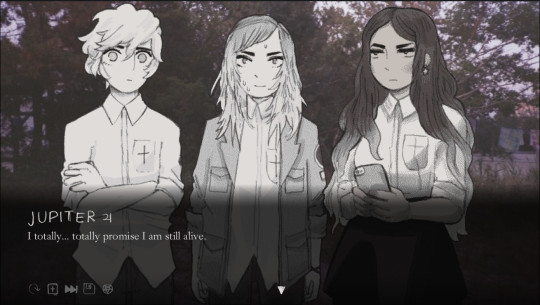
Q: Were there any particular visual novels that influenced you?
A: Yes! The reason why I started getting into visual novels specifically in 2015 was that because that was the year We Know The Devil came out!
We Know The Devil totally shifted my viewpoint as to what a visual novel could be—no diss to dating sims, but before WKTD, I, like most people, just saw VNs as dating sims and occasionally something like the When They Cry series.
WKTD totally changed that for me—a short, incredibly contained story that also managed to be about so, so much, in a surreal, horror-inspired atmosphere . . . it really blew me away! Not only was it the game that got me into visual novels, but you can definitely see a lot of its influence on Us Lovely Corpses.
Besides WKTD, there was also Her Tears Were My Light, a fairly minimalist love story that used the "rewind" function in Ren’Py as part of the story. Utilizing mechanics as part of the narrative was a really cool idea to me that also ended up in ULC. (side note: I met and hired Alex Huang to do the music for Us Lovely Corpses because I loved the soundtrack for HTWML so much!)
Finally, I was really into the original Gyakuten Saiban (Ace Attorney) trilogy when I was younger, and the evidence gathering segments were a big part of those games. I originally envisioned the "rose clipping" segments of ULC like those parts, where you'd have to select each rose before cutting it, but sadly that was a little too complex for me at the time, and I eventually decided to go for something more simple in order to complete the game. But that initial idea was a big part of what made me try Us Lovely Corpses as a game, so it ended up still being a big influence in the end!
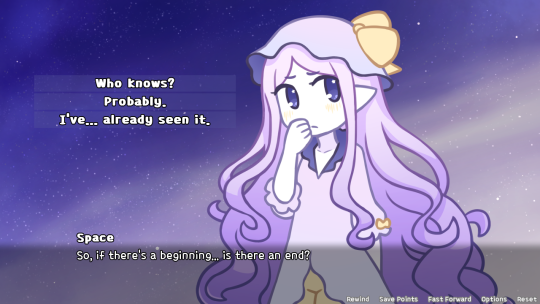
Q: Besides technical things like those mechanics and the exploration element, do you find that you have a different style of writing in visual novels as opposed to the stories you've done in other formats, like twine and comics?
A: I'm not sure if this is always the case for visual novels, but I find I have to format my writing differently when writing for VNs—specifically, in length of sentences and paragraphs. I've found my writing worked a lot better in Us Lovely Corpses the more I broke everything up into smaller fragments—larger ones or paragraphs didn't work as well, which can be a problem for me because my writing can tend to get a bit wordy!
This has to do a lot with the pacing of visual novels and how the player/reader is a big part of that. Control over pacing is a big part of why visual novels appeal to me, but you also have to think differently to get the best result.
Technical stuff aside, I found that, at least for ULC, my actual writing style remained pretty much the same. I think this has the benefit of making the writing in Us Lovely Corpses seem unique, but has the disadvantage of posing a problem for a certain something I didn't see coming at all: Let’s Players!
A few people have made videos of their playthroughs of Us Lovely Corpses, which is incredibly exciting, but when I watch them, I can't help but feel bad for them because they always read everything out loud . . . which means, with my somewhat wordy style, they have to do a LOT of talking!
I haven't actually gotten complaints about this or anything, but I still hope people who make videos of their playthroughs of ULC keep some water nearby!
Note: the next part of the interview contains spoilers for Us Lovely Corpses, as well as discussion of mental illness.

Q: As the story progresses, it becomes explicitly clear that the “monster” is Marisol’s bipolar disorder. Did you ever think about leaving the metaphor more ambiguous, and if so, what made you decide to be so direct instead?
A: I'd say if the "monster" was one specific thing, it would her Ocular Rosaceae, as it's the one specific thing that gives a physical form to Marisol's thoughts and unhealthy behaviors. But even that, in a way, is not taking into account her bipolar disorder and depression, her jealousy towards Alex, her self-loathing and introversion . . . "the monster" is all of those things, because at its core, the monster is mental illness. And mental illness is never just one thing, but many things and factors interacting at once to create something much bigger than a single diagnosis.
All that said, it's not incorrect to say that Marisol's bipolar disorder is the monster; it's just more accurate to say it’s part of Marisol's monster. Back when ULC was still a comic, I wasn't going to talk about specific diagnoses, but as the story grew I realized I wanted to talk more explicitly about mental illness. I don't exactly remember where the idea came about, but early on in the writing process I got that idea in my head of Alex finding that fake corpse and finding that doctor's diagnosis. In retrospect, it was a really, really weird scene, especially as it comes right off the heels of realizing what you thought was a dead body was just a weird joke, but I do like what it represents—in the middle of this surreal trip into a house filled with talking flowers, the story suddenly halts as you soak in this very blunt reminder that, magic aside, this is a world that is representative of the real world. Marisol may have a magical disease and be best friends with a witch, but she's a very real girl, so to speak.
So that harsh reminder is part of why I wanted to be so direct. I guess the other part would be that I just wanted to make no bones about it. Some things you want to leave up to interpretation, and some things you don't. From the very, very beginning the story was always about mental illness, so it just felt right to me to be upfront about it.
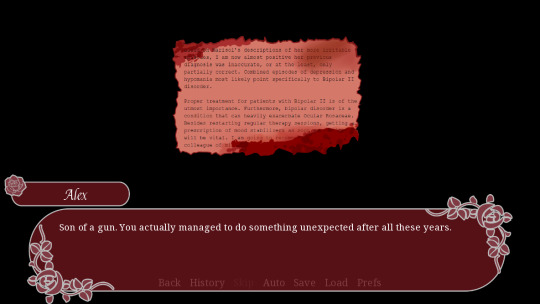
Q: One thing I noticed that I thought showed a lot of attention to detail in ULC was that in one of the rooms you explore there are two famous paintings that both have connections to suicide (Millais’s Ophelia and van Gogh’s Wheatfield with Crows). Are there any other little symbolic details like that you added to the story that some readers might have missed?
A: Ah, I'm glad you caught that! If I had stuck with the more Ace Attorney style of gameplay I would have liked to put more small details like that in. As it stands, the big example is probably pretty obvious—Alex's notes about each rose are fairly close to the standard "flower language" of different rose colors in real life. The fact that yellow roses can mean "jealousy" or "friendship" depending on what source you use actually ended up working very well with the story.
The last names of Alex and Marisol are probably pretty obvious: de Rosa ("of the Rose") and Flores ("Flowers"). Something that's probably less apparent is Marisol, a name that originally comes from a contraction of "Maria de La Soledad" ("Our Lady Of Solitude"), one of the titles given to the Virgin Mary.

Q: Was the flower language the reason you used roses rather than any other flower, or were there other inspirations for that as well?
A: There were a number of reasons! One being that Revolutionary Girl Utena was a big influence on my style and particularly on several parts of the game. There's also the whole dichotomy with roses/thorns. And there's also the simple fact that I have fun drawing roses!
Q: For my last question, are you working on any other visual novels right now?
A: I am as a matter of fact! I'm working on a visual novel set in Japan about some high school kids who explore a strange house. It's still in fairly early stages, but I think if I give it my all I will actually have a demo ready in time for Halloween, which would be great!
I’m definitely looking forward to seeing that demo—even more so after learning about all of the serious thought d Marie Licea puts into the details and themes of her work. If you’re as excited as I am about updates on her upcoming projects, you can follow her on itch.io or twitter, and considering supporting her patreon. Thanks for reading!
72 notes
·
View notes
Text
Revolutionary Girl Utena Episode 4 Liveblog
Join us this week for discussions of time, projecting fantasies onto others, non-diegetic inserts, and “I didn’t realize this was going to be a hentai”
This episode starts with a flashforward structure, rather than a flashback to the fairytale. This is also our first two-part episode, which is something I might come back to later in the series -- every one of the Student Council gets a two-part duel at some point, most of which are in the third arc (Saionji becomes a prop for Wakaba’s story in the BRS), but Miki gets his in the very beginning. (I’m not sure what to do with Touga here, since he arguably gets two multi-part episodes, one in the first arc and one in the last arc.)
Regardless, opening with letting us know that Utena will have to face Miki in the Dueling Arena is a unique choice here. No other characters get that kind of flashforward. I think that this happens for a few reasons. The kind of obvious, teaching you how to watch the show reason is that this is our first duel with someone other than Saionji, and we are being told by the series both that the characters aren’t what they seem at first glance (sweet, gentle Miki is shown to be possessive and antagonistic) and that we should, all along, not be taking these characters at face value. Having Miki challenge Utena to a duel without the flashforward would create a greater element of surprise, but surprise is not the motivating factor here -- rather, the show is telling us to look for clues as to how these characters are functioning. (I think that it also creates even more tension to know from the start of these two episodes that Miki will challenge Utena to a duel, since you are then anticipating what events could possibly lead up to it.)
The other, less surface-level answer is that Miki, of all the Duelists (well, all the ‘main’ Duelists, not counting Mikage), has the closest and strangest relationship with time. We’ve already witnessed this with his use of the stopwatch. He’s also the character who is most out of sorts with time in his story arc -- Juri has ties to the past, but it’s mostly causing her pain in the present, Saionji has ties to the past and is seeking eternity but is still doing so in the present, Nanami and Touga have some ties to time and the past but it isn’t a major structuring force for either of their characters (I would say they’re both more future-oriented than anything, but not strongly so). Miki, by contrast, is constantly seeking to recapture a lost past that he never really /truly/ had access to. All he has is his memory, tainted heavily with nostalgia, of a childhood he never really got to live or enjoy because he’s a prodigy, and his creepy af fantasies of returning to a sense of oneness with his twin. His entire motivation is about reliving and trying (in vain) to access an idealized version of the past, while he both resists and struggles to fit normatively into the adulthood he is moving towards. It would make sense for these reasons to have the opening of his first set of focus episodes place both him and the audience out of sorts with time by using this flashforward structure (and the later ambiguous transition that makes the flashforward seem almost like a memory).
I would like to take a moment to also appreciate Juri taking the place of Touga as the person dramatically watching from the sidelines. Where even is that location? How many stairs are there to get up there?
We move directly into the next scene with little in the way of fanfare -- there’s a bit of a dissolve, but the music continues, so it seems like a subjective view or memory of Miki’s, which gives some ambiguity to when the scene with Nanami takes place. Is it after the duel and Miki is just moping around after losing, or does it take place before? It takes place before (as later plot developments show, but looking at it closer, it’s left pretty ambiguous in terms of cinematic structure, if not in terms of narrative.
Miki is also a dramatic edgelord in this scene and I feel like he’s always seen as so soft and sweet and innocent that people forget this side of him. He’s just as extra as the rest of the Duelists.

This is a pretty ambiguous line -- we’re led to think that “she” is Anthy, since Nanami finds Anthy’s photo right after this line is spoken, but it could just as easily be Kozue. Of course, we don’t know that Kozue exists yet on a first watch, so the ambiguity only works on subsequent viewings. But since Anthy becomes a Kozue stand-in for Miki, I feel like this comparison works.
Anthy slap count: 4
(drink another shot!)
Miki timed the exact moment when he needs to go rescue Anthy from the Mean Girls Brigade with his stopwatch. Oh my god. How extra can you be.

I haven’t gone through and tested this theory, but I feel like Miki episodes are far more likely to get non-diegetic inserts like this one. It’s meant to punctuate the scene (marking in this case Miki blushing when anthy thanks him for saving her), and I’m wondering why these tend to show up the most in his episodes. Does he have the most tenuous grip on the diegetic world of the show (see also: the stopwatch)? Is there something about Miki’s character on a diegetic level that would make sense for there to be a lot of non-diegetic inserts (such as his living in a fantasy world moreso than the other characters, despite all of them having to face ‘reality’ in some way or another, even if that ‘reality’ is the construct of the narrative)? Regardless, these moments really point to the ways in which the narrative structures here start to break down.
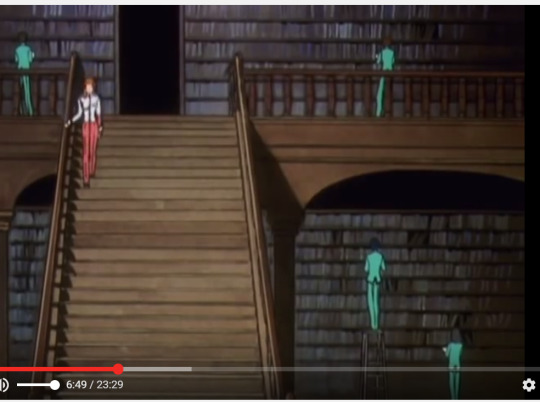
We interrupt your scheduled liveblogging to present Juri dramatically walking down the stairs in the coolest library your school will never have. (I believe the library set makes a reappearance in the BRS, but is largely underutilized.)
We also bring you
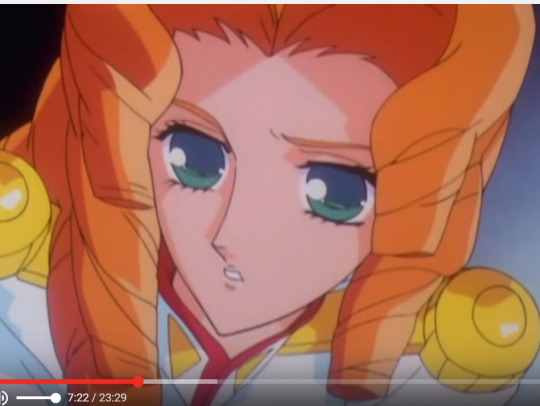
Juri’s utter confusion at Miki talking about happiness, and quickly changing the topic. “Happiness? what’s that?”
Though, this scene shows part of what Miki’s problem is -- instead of focusing on what he can do to better himself and create his own happiness, he places all of that happiness on the idealized figure of another person. I can’t decide if this is a typically feminine trait or if he’s doing it in the typically masculine (after all, the Manic Pixie Dream Girl exists as a trope) way.
Another scene of Utena being shocked by someone having the ring...how has she not learned yet that the people with the weird outfits are part of the Student Council? Is it really that much of a shock?

While Anthy is, by now, used to being the site of projected fantasies by others, this particular projection is one that puzzles me more the more I think about it. Up to this point, we’ve pretty much only seen Anthy in Rose Bride persona -- meek, submissive, ultra feminine -- and we haven’t seen her ‘witch’ persona yet (at least, nothing more than the tiniest of hints of it). We haven’t seen Kozue at all, and I feel like her reveal is meant to be a bit of a shock that contrasts to Anthy (or the Anthy we see here), but even so, Kozue must be the site of even more projection by Miki, since she is brash and revels in being the ‘bad girl’ and is about as far from this side of Anthy as you can get. What is it about Anthy, then, or at least the side of her we see here, that reminds Miki of Kozue, besides his own highly rose-tinted memories of her?
Then again, they may be more similar upon a rewatch than we see at first glance.
I think that the way that Miki talks about the mysterious “girl he knows” is meant to make her seem distant, like he no longer knows her, or like she died, or something along those lines, but she’s still very much in his life. Hell, they still live together. Here it’s more of a metaphorical distance than a physical or temporal one. It’s also building up the slow reveal of Kozue, and an opportunity for Miki to be even more dramatic. ;]
How much do you want to bet that Anthy failed her test on purpose as an excuse to push Miki into dueling?
The scenes where Miki is playing piano seem to corroborate the issues with the sense of time that his episodes have. I’d post a gif if I could, but his movements aren’t fluid here -- he pauses in one area and then it fades to the next pose -- creating a sense of being out of joint with time. (I think part of this is to save on animation costs -- fewer inbetweens when they have a more complicated lighting scheme -- but it still holds)
And we all know that music is an inherently temporal medium.
Also, Touga showed up out of literally nowhere just now.

These shots move between diegetic (subjective viewpoint, or a memory) and non-diegetic, it seems. They seem to be non-diegetic inserts during the duel itself, but here, it seems to be a memory.
Note the way that it is drawn to look like a photo in an album or illustration in a children’s book. This isn’t a “real” memory, but rather an ideal.

The butterflies even float on top of the picture, leaving drop shadows, further cementing this as subjective, not objective.
I don’t have too much to say about the Shadow Girls play this time, though it is operating on two levels: one is the surface level of warning you that the girl you seek may not be what she seems (both Anthy and Kozue in this case), and the other is the level of “wow B-ko’s first love was kind of an asshole if he left her over things as trivial as liking pro wrestling,” which is to say, it’s also an indictment of people like Miki who project their fantasies of what a ‘proper’ girl should be onto their love objects.
I don’t have much to say about the “Operation: Himemiya Anthy is a weirdo who keeps a [weird animal] in her [domestic space]” segment (though I do thoroughly enjoy it), aside from noting that it speaks to this sense of projection -- not only is Miki so enamored with Anthy that he thinks it’s cute that she has a pencil tin full of snails, but Nanami is wanting to project her own weirdness onto Anthy for the sake of the others. Nanami is the one walking around with a live octopus in her bag, but she’s not the weirdo -- Anthy is.
Nanami really does have the best magical thinking of any of the characters, though. It’s exactly like a 13 year old to /keep trying these things/ even though it’s obvious that it’s not going to work, and even if it wasn’t obvious from the start, it should have been after the first failed attempt.
I do enjoy the snail getting a spinning rose frame, though.

I’ve seen enough hentai to know where this is going.

I’m not sure I understand the moment with the elephant flipbook. She starts laughing uncontrollably while playing with it, and Utena tells her to be serious. Is she actually laughing at the pranks she just played on Nanami and can’t control herself? Is she actually enjoying herself with the flipbook? Is it (along with the animals and the shaved ice) meant to show her as childish? Is it foreshadowing for the elephants that will arrive in a few episodes?
Nanami’s outburst here is interesting for a few reasons, as well. She seems to be concerned with the fact that while Anthy seems to be the image of the ‘proper’ feminine love object for many people, she’s actually rather improper, as we have seen all episode. While this is at least partially a policing of other women’s femininity, it can also be seen an Nanami starting to see through Anthy’s facade and the facade of the entire dueling game, whether she realizes it or not, long before she simply rejects the system altogether.
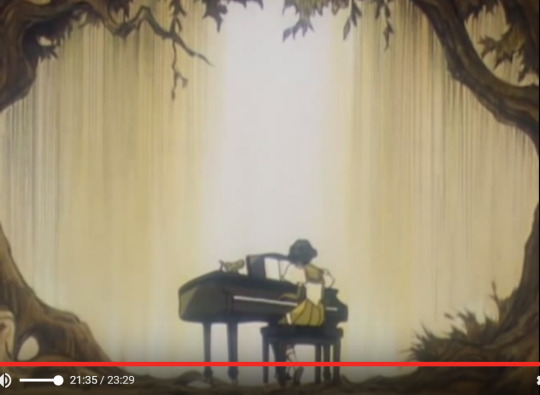
And we conclude with explicitly pointing to the ‘sunlit garden’ as a site of fantasy, not of real memory, as shown by substituting Anthy into the memories/photographs.
Join us next week for the thrilling conclusion! Will Miki duel Utena? Will he win Anthy’s hand? Will he ever regain his ‘shining thing’? Is Kozue one of the best characters in this show?
As always, if you have comments or want to discuss anything in more depth, please do so.
#revolutionary girl utena#utena liveblog#long post is long#not blog themed#miki kaoru#lots of shitposting about juri in this one actually#oh well#sometimes you gotta shitpost about the waifu
12 notes
·
View notes